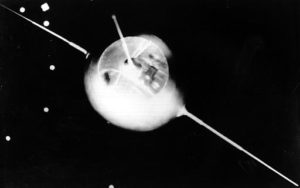By: Paige Randall
70 years ago mankind took its first leap to the stars.
From deploying some of the first high altitude planes to putting a man on the moon, NASA continues to press forward further and further into the the unknown galaxy. In 1958, the National Aeronautics and Space Administration was formed to compete with the Soviet Union, giving birth to an era that would greatly impact the course of science education in the United States. Now with new technologies and destination in mind, NASA continues to have an influence on the students of the American schools systems.

On October 4th, 1957, the Soviet Union launched Sputnik, the first artificial satellite, into orbit. This satellite, which was only 22.8 inches in diameter, took 98 minutes to orbit the earth. The launch of this satellite set the United States scrambling to keep up with the Soviets. The US feared the Soviets would soon have the capabilities to launch more dangerous projectiles such as missiles or nuclear bombs. The United States answered with NASA, which was officially organized on July 29th, 1958.
Shortly after its organization, in 1961, President John F. Kennedy helped initiate the Apollo program. The end goal was to land on the moon by the end of the 1960’s. When adjusted for inflation, the total cost came to 206 billion dollars, making it one of the most expensive American scientific projects ever.
After three preceding Apollo missions, Apollo 11 touched down on the moon on July 21st, 1969.
Astronauts Neil Armstrong and Buzz Aldrin became the first two humans to ever walk on the moon. It was on this mission that Armstrong spoke his famous words, “That’s one small step for a man, one giant leap for mankind.” The arrival at the moon signified the end of the space race, but the effects of it were not over.

While NASA was playing its part in the space race, the American education system fulfilled another role. After the US realized that the Soviet Union had the capability to launch something into space, the American schools began to focus on science, math, engineering, and technology, or STEM, subjects. Fearing that the Soviets were more advanced, US schools emphasized STEM subjects with the hope of creating future technology and engineering advancements.
Although the space race is over, its impact is still present today. NASA continues to develop new technologies and discover more about this universe. After the retirement of the space shuttle program in 2011, NASA has set its sights on unmanned missions, such as the Curiosity Rover and the New Horizons.
The Curiosity Rover landed on Mars on August 26, 2012. Since then, the rover has studied the martian climate and geography. Another big part of the Curiosity’s mission is to asses the planet in order to help plan for future projects. According to their website, NASA hopes that Curiosity, as well as other planned missions, will help prepare them to send manned missions to Mars one day.
Unlike the Curiosity, New Horizons has its sights set on things much farther away than Earth’s nearest neighbors. Launched in 2006, New Horizons flew by Pluto on July 14th, 2015, offering Earth never before seen images of Pluto. New Horizons is planning on continuing past Pluto and on to the Kuiper Belt, where it will arrive around 2019.
As NASA continues to explore the galaxy, the education in the United States is refocusing on STEM subjects once more, just like during the Space Race. According to the National Math and Science Initiative, the amount of STEM jobs will grow up to 17% in the 10 years, which is a significantly higher rate than the expected 9.8% growth of other fields. The NMS argues that the United States needs to dramatically increase STEM education to keep up with the fast technological advances of the world.
In the coming years, school districts around United States, such as Hershey, could see these STEM subjects become more prevalent. By teaching these subjects, a new generation of students could be inspired to take their place among the stars.
As NASA administrator, Charlie Boden, said in a recorded message for the Curiosity rover to play on Mars, “Since the beginning of time, humankind’s curiosity has led us to constantly seek new life…new possibilities just beyond the horizon.”





